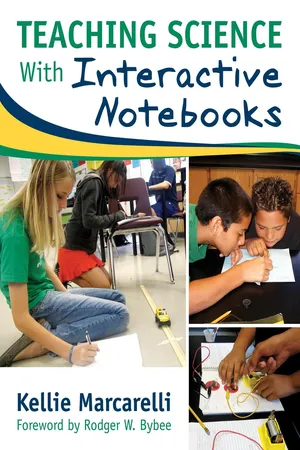
- 192 pages
- English
- ePUB (mobile friendly)
- Available on iOS & Android
Teaching Science With Interactive Notebooks
About this book
"Easy to read, with good examples and illustrations. The rationale is spelled out for every step, the setup for the interactive notebook is clearly explained, and you can hear the enthusiasm of the author, which makes the reader enthusiastic about trying the strategy."
—Maria Mesires, Seventh-Grade Science Teacher
Case Middle School, Watertown, NY
"In an era when science teachers are being asked more and more to teach writing skills and build science literacy, this book presents an engaging and creative way to answer that challenge and encourage the use of higher-order thinking skills."
—Michael Baker, Eighth-Grade Science Teacher
Memorial Middle School, Albany, OR
Increase student learning in the inquiry-based science classroom!
Interactive notebooks allow students to record and analyze observations, reflect on their learning, and self-assess their work. Teaching Science With Interactive Notebooks gives educators a step-by-step process for introducing interactive notebooks to students and using notebooks to develop students? communication skills, cognitive organization skills, and sense of responsibility for their own learning.
Packed with examples from actual student notebooks, this detailed guide explains the unique features that make interactive notebooks more effective tools than conventional notebooks for science classrooms. This resource:
- Describes the nuts and bolts of implementing interactive notebooks, including execution, time management, and grading
- Uses the 5E Learning Cycle (engage, explore, elaborate, extend, evaluate) as the framework for science instruction
- Emphasizes the importance of writing in science and provides strategies for modeling effective writing
- Explores strategies to encourage collaborative student inquiry and foster whole-class discussions
By implementing interactive notebooks in your classroom, you can gain deeper insight into each student?s understanding, learning progress, and thinking!
Frequently asked questions
- Essential is ideal for learners and professionals who enjoy exploring a wide range of subjects. Access the Essential Library with 800,000+ trusted titles and best-sellers across business, personal growth, and the humanities. Includes unlimited reading time and Standard Read Aloud voice.
- Complete: Perfect for advanced learners and researchers needing full, unrestricted access. Unlock 1.4M+ books across hundreds of subjects, including academic and specialized titles. The Complete Plan also includes advanced features like Premium Read Aloud and Research Assistant.
Please note we cannot support devices running on iOS 13 and Android 7 or earlier. Learn more about using the app.
Information
1
Introduction

WHAT IS AN INTERACTIVE NOTEBOOK?
HOW ARE INTERACTIVE NOTEBOOKS USED?
WHAT ARE THE BENEFITS OF USING INTERACTIVE NOTEBOOKS?
Preparing Students to Compete Globally
- Starting earlier in the student’s developmental stage;
- Monitoring the gap between minority and majority social classes;
- Providing opportunity to challenge students, to push them further;
- Using computers to support instructional goals rather than just to be using them;
- Providing inquiry lessons that bridge relevant content; and
- Involving the community.
- Connecting students’ thinking and experiences with science concepts;
- Engaging students in collaborative inquiry as a way of learning science content;
- Providing opportunities for all students;
- Creating a concrete record of reflection, assessment, and connections that can be viewed and discussed;
- Developing academic language; and
- Providing students with an opportunity to think critically and make informed decisions.
Increasing Communication Between Stakeholders
Table of contents
- Cover Page
- Dedication
- Title Page
- Copyright
- Contents
- Foreword
- Preface
- Acknowledgments
- About the Author
- 1. Introduction
- 2. Organizing Notebooks for Learning
- 3. Gaining Student Buy In and Ownership
- 4. Using Notebooks During Investigations
- 5. Getting Started: The First Three Days
- 6. Using the Notebooks: Days Four to Seven
- 7. Learning Through Writing
- 8. Learning Through Discussion
- 9. Conclusion
- Resource A: Reproducibles
- Resource B: Crosscurricular Connections
- References and Further Reading
- Index